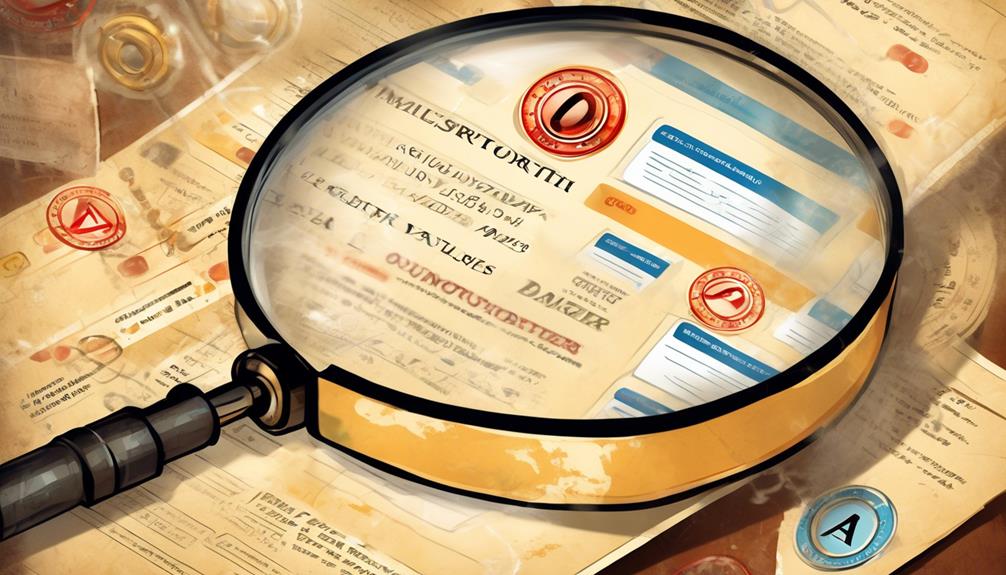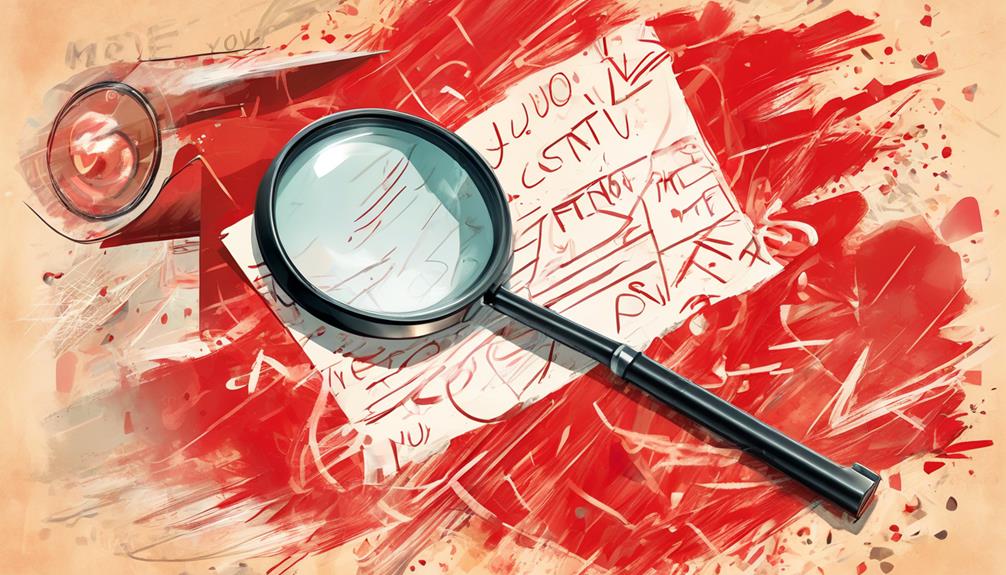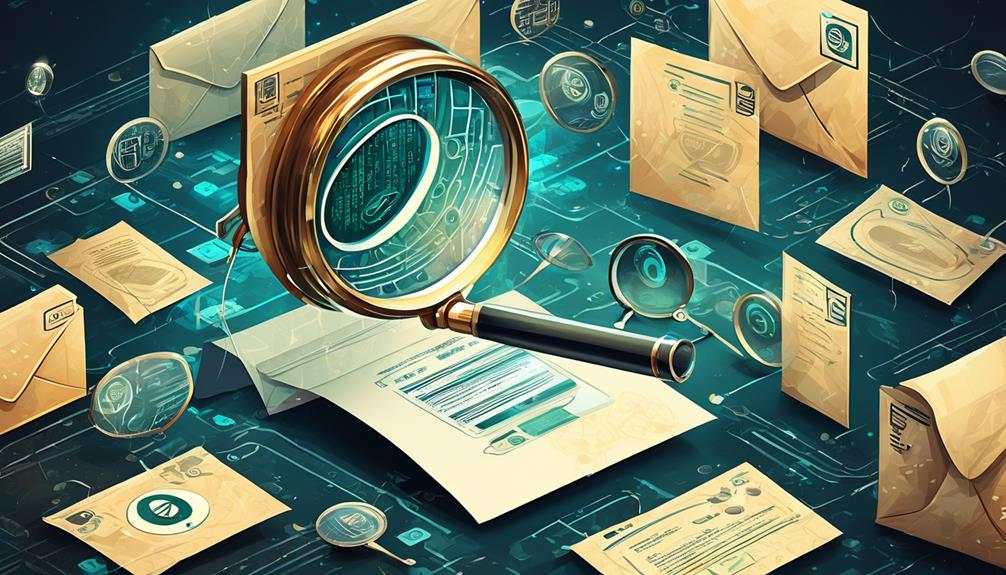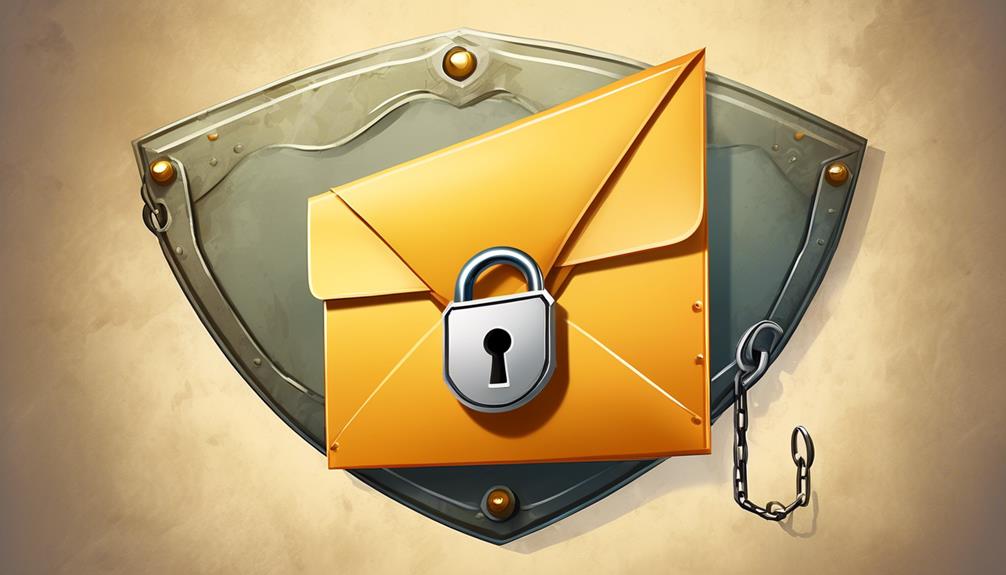In the vast digital world, countless emails reach our inboxes daily. It's vital to scrutinize these messages with keen awareness. Cyber threats lurk in the shadows, making vigilance essential. Professionals don't just bypass obvious spam; they spot subtle dangers. They know checking sender details exposes email deceptions. Legitimate companies don't typically use urgent, pressuring language.
Peeling back layers, one may question link authenticity. Spelling mistakes often signal danger. Small details, like impersonal greetings or odd attachments, reveal true motives. With scam sophistication increasing, knowing how to spot unsafe emails is imperative. What are the best practices for ensuring online safety? The answers are forthcoming, offering guidance for navigating the digital landscape securely. Transitioning to these techniques will ensure a safer journey through our constant stream of messages.
Scrutinize Sender Information

A critical step in detecting unsafe emails is to meticulously examine the sender's information for authenticity and potential red flags. Sender credibility often hinges on the email domain from which the message originates. An authentic domain aligns with the supposed sender's established web presence, thus a discrepancy here is a telltale sign of deception.
When assessing an email, the recipient should not only verify the display name but also scrutinize the actual email address. A seemingly familiar sender name paired with an incongruous email domain warrants skepticism. It's not uncommon for malicious actors to use domains that mimic legitimate ones, leveraging subtle misspellings or misleading domain extensions to dupe unsuspecting individuals.
Moreover, analysis of the domain itself provides insight into the sender's legitimacy. A trusted domain typically has a history and a digital footprint that can be traced and validated. Conversely, a domain created recently or one that lacks a professional web presence may signal a lack of sender credibility. It's imperative for individuals to foster a sense of community in their digital interactions, wherein they're vigilant and supportive of one another in identifying and flagging such deceptions. This collective watchfulness is the bulwark against the threats posed by unsafe emails.
Assess Urgency Claims
Cybercriminals frequently use haste to their advantage. Therefore, it's essential to spot pressure tactics in email exchanges. By adopting an analytical approach, one can scrutinize the legitimacy of deadlines. This analysis often uncovers discrepancies indicative of phishing scams. When an email demands sudden action, it's wise to question the urgency. Consequently, always pause before acting on such requests.
Identify Pressure Tactics
Attackers often use false urgency in unsafe emails, coercing recipients to act quickly. Typically, they employ urgency indicators, such as 'immediate action required' or 'limited time offer'. These phrases disrupt rational thinking, urging quick decisions. Consequently, this rush compromises the ability to judge an email's legitimacy.
Additionally, attackers misuse trust triggers like well-known logos or signatures. They do this to make urgent claims seem credible. To counter such pressure tactics, it's advisable to pause. Analyze the email's request, considering the sender's identity and the situation's plausibility.
Groups seeking security should remain vigilant. Especially, they must question any claims of urgency to ensure authenticity.
Analyze Deadline Legitimacy
When assessing email deadline legitimacy, it's crucial to examine urgency claims. Look at the context and interaction patterns with the sender. Deadlines become suspicious if emails pressure with short response times. Users should reflect on past interactions. They must consider if such rapid turnaround is typical for the sender or their organization.
If the urgency seems unusual, it could be a tactic. The aim might be to provoke an impulsive reaction, bypassing rational thought. The community is advised to confirm deadline authenticity. Contacting the sender through secure channels is recommended. This step helps protect personal information and ensures the group's digital safety.
Question Unexpected Urgency
Assessing deadline legitimacy is essential. Additionally, we must scrutinize unexpected email urgency, questioning the underlying rush motives. Importantly, the community should remain vigilant. Recognizing that urgency signals could be manipulative is vital. These tactics are often used by cyber attackers to impair rational thinking.
It's critical to question the urgency pattern. We need to ask: Does it match the sender's usual communication style? Demands for immediate action in an email, especially regarding sensitive data or financial matters, are alarming. Such instances should prompt users to pause and analyze.
Perhaps reaching out via an alternate, trusted method to the apparent sender is wise. By collectively questioning unexpected urgency, we enhance our defense. Ultimately, this strategy improves our chances to outwit exploiters of our instinctual swift response.
Analyze Link Legitimacy
Analyzing email links is crucial for digital security. It helps identify threats. Inspecting links and tracking URLs is essential. It is necessary for those in cyber-aware communities. Scrutinizing email URLs can show if they are safe. Or if they lead to malicious domains.
Individuals should hover over links before clicking. This reveals the true URL. It allows for a preliminary safety check. Look for misspellings or character swaps. These may signal a phishing attempt. Cybercriminals often use these tactics to deceive users.
Furthermore, URL tracking tools add extra analysis. These tools check links against databases of harmful sites. They provide insights into a link's origin and path. Consequently, they are crucial for detecting phishing attempts.
Look for Spelling Errors

Spelling mistakes in emails can suggest phishing. Therefore, one should scrutinize for language anomalies or oddities. Adopting an analytical approach is essential. Each sentence must be dissected with care to find grammar issues, possibly indicating malice.
It's not solely about random typos. In fact, emerging patterns are the concern. These should alert the attentive reader. Users must feel at home in their email communities. An email with unusual language could mean an intruder's presence.
Grammar issues, like subject-verb mismatches or tense errors, break the linguistic harmony. Safe messages usually share a common language style. Moreover, recurring typos or cleverly placed mistakes need attention. They might be trying to bypass spam filters.
These patterns could be subtle, yet they reveal much about the sender. Observing closely, with attention to detail, is vital. It helps distinguish safe messages from risky ones. This vigilance is key to maintaining one's digital security.
Review Email Greetings
Email greetings are scrutinized, often unmasking phishing clues. Generally, generic salutations suggest the sender lacks a real relationship with the recipient. Conversely, personalized greetings usually signal professionalism. By cautiously evaluating an email's introduction, one can avoid accidentally revealing confidential data.
Generic Greeting Warning Signs
Emails starting with 'Dear Customer' or 'User' often signal danger. Typically, these are red flags for phishing or malicious intent. It's crucial to analyze greeting patterns in cyber threat prevention. Attackers tend to ignore cultural norms, choosing generic salutations instead. These one-size-fits-all greetings miss the personal touch found in legitimate emails.
This tactic exploits our desire for inclusion. The attackers bet on the likelihood that someone will respond to a broad message. Email users must be vigilant and question such impersonal openings. Genuine organizations usually use personal names, indicating a real relationship. Therefore, a generic greeting might not be a simple mistake; it could be a strategy to lure unsuspecting individuals into a deceptive sense of belonging.
Personalization in Professional Emails
In contrast to phishing attempts, professional emails often include personalized salutations. These reflect a real connection between sender and recipient. Personalization is crucial in email etiquette. It greatly influences the message's authenticity.
Firstly, using the recipient's name builds rapport and indicates a genuine interaction. Furthermore, mentioning previous communications or shared experiences increases trust. Additionally, content tailored to the recipient's interests shows careful consideration. Lastly, signature styles with the sender's full information enhance transparency and credibility.
Individuals who seek a sense of belonging value this personal approach. It promotes community and respect in professional exchanges.
Analyzing Greeting Authenticity
To assess email greeting authenticity, closely examine personalization and relevance. Experts recommend a vigilant approach. Look for greeting inconsistencies, which may reveal unfamiliarity. It's not merely about replacing 'Dear Customer' with a name. It's crucial to notice tone or formality level mismatches. Additionally, cultural cues are telling. An authentic sender adheres to cultural norms. They choose greetings that suit the relationship and occasion. Deviations from established patterns could indicate a disconnection. For those seeking belonging, recognizing such mismatches is key. It helps guard against potentially unsafe email interactions.
Verify Email Attachments
One critical step in safeguarding against cyber threats is to meticulously inspect attachments before opening them to ensure they are free from malicious content. Attachment safety is not merely a recommendation, it's a necessity in a world where cybercriminals tirelessly innovate ways to compromise systems. Users must be vigilant and perform malware scans on every downloaded file, regardless of the source's perceived trustworthiness.
The community seeking to protect its members from digital harm should consider the following bulletproof strategies:
- Scan with Antivirus Software: Always use updated antivirus software to scan attachments prior to opening them. This is your first line of defense against hidden malware.
- Check File Extensions: Be wary of file types that are commonly associated with malicious software, such as .exe, .scr, or .zip files.
- Confirm Sender Authenticity: Double-check the sender's email address and verify with them directly if the attachment was intended and is safe to open.
- Use a Sandbox Environment: Open and run attachments in a sandbox environment to observe behavior without risking the integrity of your main system.
Understand Anti-Phishing Techniques

While detailed email inspection is crucial, recognizing phishing is also key. Robust techniques are necessary for thwarting these threats. They include various tools and strategies. These are designed to identify and neutralize phishing before security breaches occur.
Training programs significantly enhance phishing detection abilities. They educate users on the latest tactics and spotting malicious clues. This education fosters a cybersecurity-aware culture. Consequently, the risk of phishing attacks can be reduced.
Additionally, practical skills are reinforced through phishing simulations. These mimic real attacks, providing a safe practice environment. Individuals can then apply knowledge and sharpen detection skills. Feedback sessions follow simulations, allowing for learning and vigilance improvement.
A community of informed users is the result of these efforts. It creates a group that values cybersecurity. This unity strengthens the human firewall. It becomes a formidable defense against phishing.
Frequently Asked Questions
How Can I Safely Report a Suspicious Email to My Company's IT Department WIThout Accidentally Compromising SecurITy?
She ought to adhere to her company's email guidelines. By utilizing designated reporting tools to forward the suspicious email, she collaborates. This approach ensures her participation in team efforts. Simultaneously, it mitigates the risk of a security breach.
What Steps Should I Take if I've Accidentally Clicked on a Link or Downloaded an Attachment From an Unsafe Email?
Firstly, she should quickly disconnect her device from the internet, thus preventing any additional harm. Next, she will thoroughly scan the attachment for potential threats. Additionally, comprehending the psychology behind phishing will help her recognize how the error occurred. Finally, she should seek advice from the IT department for further assistance.
How Does Email Encryption Contribute to the Safety of Email Communication and How Can I Tell if an Email Is Encrypted?
Encryption enhances email security with password protection and digital signatures. Interestingly, she can detect encryption by examining digital certificates. Consequently, this ensures communications remain within a trusted network.
Are There Specific Legal Consequences for Organizations That Fail to Protect Their Employees From Unsafe Emails?
Organizations that disregard compliance duties risk legal consequences. Specifically, they face fines for failing to protect employees from unsafe emails. Additionally, their community's trust diminishes, impacting the feeling of security and belonging.
Can the Use of Email Filters or Spam Blockers Replace the Need for Employees to Learn About Detecting Unsafe Emails?
Email filters serve as a protective net, intercepting numerous threats; however, they are not foolproof. Consequently, user training in phishing awareness is essential. It represents the personal armor that employees require. This armor is vital to safeguard against the deceptive baits that filters overlook.
Conclusion
In conclusion, using these strategies can reduce the risk of malicious emails. Imagine a cautious employee. They receive an urgent data request. Before responding, they check for email oddities. This vigilance prevents a potential data breach. By carefully checking sender details, they stay safe. Also, they avoid urgent tricks and verify links. Moreover, they examine the language and attachments. Individuals become equipped to face cyber threats. Understanding anti-phishing is crucial in the digital era.



